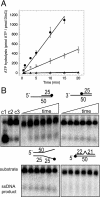Staphylococcus aureus DinG, a helicase that has evolved into a nuclease
- PMID: 22166102
- PMCID: PMC3270479
- DOI: 10.1042/BJ20111903
Staphylococcus aureus DinG, a helicase that has evolved into a nuclease
Abstract
DinG (damage inducible gene G) is a bacterial superfamily 2 helicase with 5′→3′ polarity. DinG is related to the XPD (xeroderma pigmentosum complementation group D) helicase family, and they have in common an FeS (iron–sulfur)-binding domain that is essential for the helicase activity. In the bacilli and clostridia, the DinG helicase has become fused with an N-terminal domain that is predicted to be an exonuclease. In the present paper we show that the DinG protein from Staphylococcus aureus lacks an FeS domain and is not a DNA helicase, although it retains DNA-dependent ATP hydrolysis activity. Instead, the enzyme is an active 3′→5′ exonuclease acting on single-stranded DNA and RNA substrates. The nuclease activity can be modulated by mutation of the ATP-binding cleft of the helicase domain, and is inhibited by ATP or ADP, suggesting a modified role for the inactive helicase domain in the control of the nuclease activity. By degrading rather than displacing RNA or DNA strands, the S. aureus DinG nuclease may accomplish the same function as the canonical DinG helicase.
Figures






Similar articles
-
Structure, function and evolution of the bacterial DinG-like proteins.Comput Struct Biotechnol J. 2025 Mar 17;27:1124-1139. doi: 10.1016/j.csbj.2025.03.023. eCollection 2025. Comput Struct Biotechnol J. 2025. PMID: 40206346 Free PMC article. Review.
-
Structure, function and evolution of the XPD family of iron-sulfur-containing 5'-->3' DNA helicases.Biochem Soc Trans. 2009 Jun;37(Pt 3):547-51. doi: 10.1042/BST0370547. Biochem Soc Trans. 2009. PMID: 19442249
-
An iron-sulfur cluster is essential for the binding of broken DNA by AddAB-type helicase-nucleases.J Biol Chem. 2009 Mar 20;284(12):7746-55. doi: 10.1074/jbc.M808526200. Epub 2009 Jan 7. J Biol Chem. 2009. PMID: 19129187 Free PMC article.
-
The AddAB helicase-nuclease catalyses rapid and processive DNA unwinding using a single Superfamily 1A motor domain.Nucleic Acids Res. 2011 Mar;39(6):2271-85. doi: 10.1093/nar/gkq1124. Epub 2010 Nov 10. Nucleic Acids Res. 2011. PMID: 21071401 Free PMC article.
-
G-quadruplexes and helicases.Nucleic Acids Res. 2016 Mar 18;44(5):1989-2006. doi: 10.1093/nar/gkw079. Epub 2016 Feb 15. Nucleic Acids Res. 2016. PMID: 26883636 Free PMC article. Review.
Cited by
-
Structure of a dimeric crenarchaeal Cas6 enzyme with an atypical active site for CRISPR RNA processing.Biochem J. 2013 Jun 1;452(2):223-30. doi: 10.1042/BJ20130269. Biochem J. 2013. PMID: 23527601 Free PMC article.
-
Cross talk between the nuclease and helicase activities of Dna2: role of an essential iron-sulfur cluster domain.Nucleic Acids Res. 2012 Sep;40(16):7821-30. doi: 10.1093/nar/gks534. Epub 2012 Jun 7. Nucleic Acids Res. 2012. PMID: 22684504 Free PMC article.
-
Genomic, Transcriptomic and Metabolomic Studies of Two Well-Characterized, Laboratory-Derived Vancomycin-Intermediate Staphylococcus aureus Strains Derived from the Same Parent Strain.Antibiotics (Basel). 2015 Feb 4;4(1):76-112. doi: 10.3390/antibiotics4010076. Antibiotics (Basel). 2015. PMID: 27025616 Free PMC article.
-
Structure, function and evolution of the bacterial DinG-like proteins.Comput Struct Biotechnol J. 2025 Mar 17;27:1124-1139. doi: 10.1016/j.csbj.2025.03.023. eCollection 2025. Comput Struct Biotechnol J. 2025. PMID: 40206346 Free PMC article. Review.
-
Type IV CRISPR-Cas systems are highly diverse and involved in competition between plasmids.Nucleic Acids Res. 2020 Feb 28;48(4):2000-2012. doi: 10.1093/nar/gkz1197. Nucleic Acids Res. 2020. PMID: 31879772 Free PMC article.
References
-
- Singleton M. R., Dillingham M. S., Wigley D. B. Structure and mechanism of helicases and nucleic acid translocases. Annu. Rev. Biochem. 2007;76:23–50. - PubMed
-
- Gorbalenya A. E., Koonin E. V. Helicases: amino acid sequence comparisons and structure–function relationships. Curr. Opin. Struct. Biol. 1993;3:419–429.
-
- Winkler G. S., Araujo S. J., Fiedler U., Vermeulen W., Coin F., Egly J. M., Hoeijmakers J. H., Wood R. D., Timmers H. T., Weeda G. TFIIH with inactive XPD helicase functions in transcription initiation but is defective in DNA repair. J. Biol. Chem. 2000;275:4258–4266. - PubMed
-
- Sung P., Guzder S. N., Prakash L., Prakash S. Reconstitution of TFIIH and requirement of its DNA helicase subunits, rad3 and rad25, in the incision step of nucleotide excision-repair. J. Biol. Chem. 1996;271:10821–10826. - PubMed
-
- Pugh R. A., Honda M., Leesley H., Thomas A., Lin Y., Nilges M. J., Cann I. K., Spies M. The iron-containing domain is essential in Rad3 helicases for coupling of ATP hydrolysis to DNA translocation and for targeting the helicase to the single-stranded DNA-double-stranded DNA junction. J. Biol. Chem. 2008;283:1732–1743. - PubMed
Publication types
MeSH terms
Substances
Grants and funding
LinkOut - more resources
Full Text Sources
Molecular Biology Databases
Research Materials
Miscellaneous

